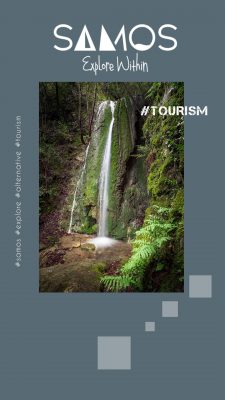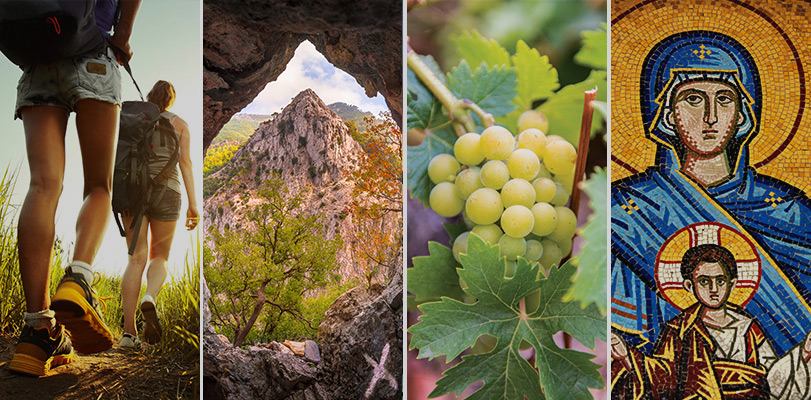Mountain Kerkis
Mountains of Samos : The best breathtaking viewpoints of the island
Kerkis is the so-called “majestic” mountain of Samos. With steep slopes, caves and forests, it became, as early as the 9th century, an important center of monastic life.
Most of its reputation comes from the life of Saint Paul the Younger from Latro of the neighboring (opposite) Asia Minor. Saint Paul the Younger came and lived in Pythagoras Cave during the early 10th century.
Many ascetics followed him and renovated, following his exhortation, three monasteries, previously destroyed by the Agarenes (Arab raiders), while the Saint himself, quite often, used to live in the cave of Saint John the Theologian.
Nowadays, according to the local tradition, Pythagoras Cave and the cave of Panagia Saradaskaliotissa, located in the southeast side of Mountain Kerkis, is one and the same cave. Similarly, the cave of Saint John the Theologian and the well-known “Kandili”, located above Drakaioi, to the north steep side of the mountain, are also one and the same cave (according to legend on “Kandili” peak, sailors can see an unexplained light).
Out of the three abovementioned Monasteries (Saint George Drakaion, Panagia Makrini and Agios Charalambos Kallitheas), the last one is decorated with frescoes made during the 18th century, while the other two Monasteries are decorated with very interesting frescoes, dating back to the late 13th century.
The mountain Kerkis or Kerketeus is located on the western side of the island. Its highest peak, called Vigla, has a height of 1.443m.
Its lower peaks are: Mavro Stefani and Seitan, while the lower adjacent mountains are: Fterias, Menelaki and Kastri. The name of the mountain has originated from the draughts and strong winds which blow there, hitting its slopes and creating various noises. From the summit, Vigla, one can enjoy the mesmerizing view of the Aegean Sea and the surrounding islands.
Kerkis is concidered to have once been a large volcano during the great geological formations. This is why its interior is hollow, and many of the holes appear to have once been craters. It is the highest mountain of the Aegean Sea and possesses wild beauty and extraordinary fauna.
In the caves of this mountain, the ancient philosopher and mathematician, Pythagoras once lived before leaving for Croton of Sicily. one of these caves is now called Pythagoras’s cave and can be visited even in the evening since this part of the mountain is illuminated, offering a fantastic sight.
The visitor can also combine his peregrination on Mount Kerkis with visits to: The cave of “Panagia Makrini”, “Agia Triada”, “Kakoperato”, and “Evagelistria” as well as the Byzantine and Post-Byzantine ascetics’ caves dating back to the 12th to the 16th century AD.
The forest on Kerkis is one of the seven Greek forests among the 100 wooded areas in Europe which unfortunately are not protected by any legislation and therefore are in danger of being lost. The others are: the mountain clump of Taigetos, Smolikas, the forest of Itamos in Halkidiki, Feggari in Samothrace, the forest of Birch trees in Rodopi and Katharo in Crete.
It is worth reading what Epaminondas Stamatiadis wrote about Kerkis (around 1900) in his work “SAMIAKA”:
In order to ascend Kerkis from Marathokambos, with an aim to examine the wonders of this mountain, one must struggle for two full days, because on no other mountain of the islands in the Aegean Sea are there so many sights as there are on Kerkis.
Leaving Marathokambos, one arrives at a footpath leading upwards. After passing a thicket of rare pine-trees, and following a tiring two-hour hike, you reach the chapel of “Ai Giannii. Near this chapel above a hill which is surrounded by huge rocks, a chasm, with a perimeter of 13 meters and with a mouth resembling a well, gapes open. The inside of the abyss seems to have been sculpted with a chisel – there is no doubt however, that this chasm was shaped in this way by “capricious” Mother Nature.
If you decide to look inside the chasm, you are overcome by vertigo and giddiness, and what makes matters worse for the observer is that if he throws a rock into it, he can hear the clashing noise made by the rock hitting against the sides of the abyss for a long time as it falls into its depths. It is thought that this abyss communicates with the sea and that when there are tempestuous seas, the same groaning sound that is made by the wild waves can be heard through it.
This chasm is called “Tripa tou Panaretou” and got its name from a man called Panaretos, who fell through it along with his companions Giannis and Andreas. Panaretos was a priest, who on the feast day of Ai Giannis Theologos, while celebrating with his company near the chapel of Ai Gianni, decided, under the influence of Muscat wine, to descend into the abyss to see what it was like inside. He therefore tied one end of a rope to a rock and holding on to the other end, began to descend. However, as soon as he had gone down a few fathoms, he was overcome by vertigo and fell to his death. His two friends, who could no longer hear him, went down in turn to see what had happened to Panaretos, but they too fell victim to their thoughtlessness.
A bit further along, on the banks of a torrent, there is a church honouring the Virgin Mary which is called “Panagia tou Hatzimanoli”, named after the man who had built it. Nowhere else can a place more suitable as a retreat for study and prayer, be found. Shadowy planes and other large trees decorate this location in the most wonderful way, while the cool ivy and multi-coloured bushes cover it like carpets. The gurgling of the water from the torrent, which never ceases to flow, the whispering of the pine trees as the wind moves them, together with the sweet song of the blackbird, pleases the ear and lightens the heart. About a 15 minute’s walk away from “Panagia tou Hatzimanoli”, there is a cave. To get there you must walk along a very narrow path which has been cut out of the slope of the mountain, while below it there is a terrible precipice that if by the slightest carelessness or strong wind you should lose your balance, you will surely meet instant death.
To enter the cave, you must go down twenty-two roughly made steps. This cave is called “Panagia Kakoperatiani”, named after the small chapel found inside. The word “Kakoperatiani” is derived from a Greek word meaning “bad passage” due to the bad condition of the road leading there. The cave has a width of eight meters and a height of ten meters at the entrance, and thirty meters in its interior. Advancing ten paces inside, you will find a man-made water basin in which water is gathered drop by drop as it drips through the cracks in the rock. Many stalactites, which have been formed by the droplets of water that for centuries have fallen from the high domes, and have become petrified, hang everywhere. “Like bunches of fruit hanging from their branches” Returning from the cave and taking a western direction, after a tormenting two-hour trek among rocks that have been sculpted by nature into acute angled or poly-faceted forms, you will reach a small plateau.
From here, after resting for a while, you can attempt the ascent to the highest peak of Kerkis, walking along a ridge, which has a northeast to northwest orientation, and which forms many giant heights, before finally leading to the highest of all,and reaching a height of 1570 meters. This peak is called Vigla, because from here, the lookouts, who lived in a small building called Vigla or watch tower- the ruins of which are preserved today- would signal to the inhabitants of the island on the arrival of enemy fleets or their movements, during the period of the struggle for independence.
In this area there is no vegetation but for a few sparse thorny bushes or aromatic herbs. They enhance the rocks with their pale-green colour. It is impossible to describe the magnificent and incomparable view from Vigla. Under the eyes of the observer, the sea spreads out like a blue-green plain and the Sporades and the Cyclades Islands from Rhodes (to the south) to Limnos (to the north), resemble trees that have been planted in this plain. “Athos” (in northern Greece), the many mountains of Asia Minor, as far as the snow-capped Taurus, islands, cities, plains, rivers, everything unfolds as if by magic, before the eyes of the beholder, who, delirious from such a panorama, casts the eyes of his mind towards the infinite master of the universe and ecstatically exclaims in unison with the prophet: “Your works have made you great, Oh Lord! You have created everything in wisdom!”



mountains of samos
The best view comes after the hardest climb...










